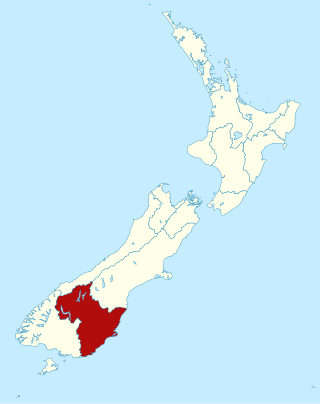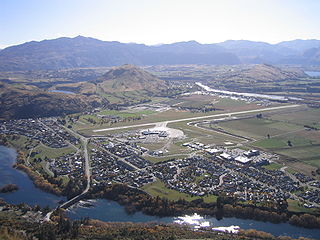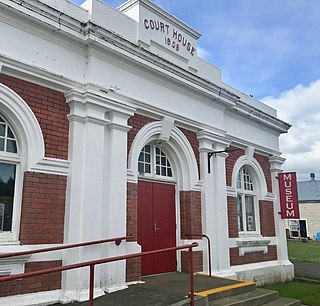
Otago is a region of New Zealand located in the southern half of the South Island administered by the Otago Regional Council. It has an area of approximately 32,000 square kilometres (12,000 sq mi), making it the country's second largest local government region. Its population was 257,200 in June 2024.

The West Coast is a region of New Zealand on the west coast of the South Island. It is administered by the West Coast Regional Council, and is known co-officially as Te Tai Poutini. It comprises the territorial authorities of Buller District, Grey District and Westland District. The principal towns are Westport, Greymouth and Hokitika. The region, one of the more remote areas of the country, is also the most sparsely populated. With a population of just 32,900 people, the West Coast is the least populous region in New Zealand. The population in the region grew by 0.4% over the year to July 2023.

Alexandra is a town in the Central Otago district of the South Island of New Zealand. It is on the banks of the Clutha River, on State Highway 8, 188 kilometres (117 mi) by road from Dunedin and 33 kilometres (21 mi) south of Cromwell. The nearest towns to Alexandra via state highway 8 are Clyde seven kilometres to the northwest and Roxburgh forty kilometres to the south. State highway 85 also connects Alexandra to Omakau, Lauder, Oturehua, Ranfurly and on to Palmerston on the East Otago coast.

Arrowtown is a historic gold mining town in the Otago region of the South Island of New Zealand. Arrowtown is located on the banks of the Arrow River approximately 7.5 km from State Highway 6. Arrowtown is located 19.5 kilometres to the east of Queenstown. As well as the route via State Highway 6 at Arrow Junction, there is also road access directly to Queenstown via Arthurs Point and a third route via the picturesque Lake Hayes.

Cromwell is a town in the Central Otago region of New Zealand's South Island, located on the shore of Lake Dunstan. Established at the confluence of the Clutha / Mata-Au and Kawarau Rivers after gold was discovered nearby during the Otago Gold Rush of the 1860s, Cromwell's location saw it become a junction for travel between Dunedin and areas further inland, such as Wānaka and Queenstown. As gold mining declined, the town developed to service farms and orchards in the surrounding area, becoming known for stone fruit and as part of the Central Otago wine region. The town remains a hub for people travelling throughout the region, with State Highway 8B running through the town and acting as a main route for travellers to Queenstown.

Milton, formerly known as Tokomairiro or Tokomairaro, is a town of over 2,000 people, located on State Highway 1, 50 kilometres to the south of Dunedin in Otago, New Zealand. It lies on the floodplain of the Tokomairaro River, one branch of which loops past the north and south ends of the town. This river gives its name to many local features, notably the town's only secondary school, Tokomairiro High School.

Lawrence is a small town in Otago, in New Zealand's South Island. It is located on State Highway 8, the main route from Dunedin to the inland towns of Queenstown and Alexandra. It lies 35 kilometres to the northwest of Milton, 11 kilometres northwest of Waitahuna, and close to the Tuapeka River, a tributary of the Clutha.

The Otago gold rush was a gold rush that occurred during the 1860s in Central Otago, New Zealand. This was the country's biggest gold strike, and led to a rapid influx of foreign miners to the area – many of them veterans of other hunts for the precious metal in California and Victoria, Australia. The number of miners reached its maximum of 18,000 in February 1864.

Ranfurly is a town in the Central Otago District of Otago, New Zealand. Located 110 kilometres north of Dunedin, it lies in the dry rough plain of Maniototo at a moderately high altitude close to a small tributary of the Taieri River. It operates as a service town for the local farming community. The town was formerly known as Eweburn, one of the "farmyard" names bestowed by former Otago Chief Surveyor John Turnbull Thomson on many small streams and locations in the district. The modern name honours the Fifth Earl of Ranfurly, who served as Governor of New Zealand (1897–1904) at the time of the extension of the Otago Central Railway to the area. Ranfurly is well known for its Art Deco buildings, such as its hotel and the dairy.

Frankton is a suburb of the town of Queenstown in the South Island of New Zealand, it was formerly a separate settlement.

The villages and then city that lay at the head of Otago Harbour never existed in isolation, but have always been a staging ground between inland Otago and the wider world. While Dunedin's current official city limits extend north to Waikouaiti, inland to Middlemarch and south to the Taieri River mouth, this articles focus is the history of the Dunedin urban area, only mentioning Mosgiel, the Otago Peninsula, Port Chalmers and inland Otago for context.

Voting in New Zealand was introduced after colonisation by Britain. The first New Zealand Constitution Act was passed in 1852, and the first parliamentary elections were held the following year.
Raglan is a former New Zealand parliamentary electorate. It existed for three periods between 1861 and 1996 and during that time, it was represented by 13 Members of Parliament.

Otautau is a small farming, forestry and milling town located inland on the western edge of the Southland Plains of New Zealand on the banks of the Aparima River. Otautau is located approximately 40 kilometres (25 mi) north west of Invercargill. The average elevation of Otautau is 60 metres.

Blair Athol (1861–1882) was a British Thoroughbred racehorse and sire. In a career that lasted little more than three months in the summer and autumn of 1864, he ran seven times and won five races including one walk-over. His wins included The Derby and the St Leger. Despite the brevity of his racing career, he was regarded by contemporary experts as one of the best British racehorses of his era and arguably the greatest horse ever trained in the North of England. He went on to become a highly successful stallion, siring the winners of many races.

Southland is New Zealand's southernmost region. It consists of the southwestern portion of the South Island and includes Stewart Island. Southland is bordered by the culturally similar Otago Region to the north and east, and the West Coast Region in the extreme northwest. The region covers over 3.1 million hectares and spans 3,613 km of coastline. As of June 2023, Southland has a population of 103,900, making it the eleventh-most-populous New Zealand region, and the second-most sparsely populated. Approximately half of the region's population lives in Invercargill, Southland's only city.
The Bruce by-election 1862 was a by-election held in the multi-member Bruce electorate during the 3rd New Zealand Parliament, on 31 July 1862. The by-election was caused by the death of incumbent MP Charles Kettle on 5 June, and was won by Edward Cargill.
The 1867 New Zealand census was held on 19 December 1867. Māori were not enumerated. The total population of people of non-Māori descent, including those from non-European countries such as China, was 218,668, plus 1,455 military men and their families. Across the country there was an average of 20.6% more men than women, down from almost 24% in 1864. This difference was most marked in Nelson Province, which had almost 38% more men than women. In Auckland Province there was only a 12% "excess" of men. Part of the discrepancy was acknowledged to be an influx of (male) miners to the gold fields. 97% of Chinese in New Zealand in 1867 lived in Otago Province, and around 18% of miners on the Otago goldfields were Chinese.
The 1861 New Zealand census was a national census of Europeans and "half-castes", taken on 16 December 1861.
The 1858 New Zealandcensus was the second national population census held in the self-governing colony of New Zealand. The date used for the census was on 24 December 1858 and the first census after the passing of the 1858 Census Act, which stated that a census of Europeans was to be held every three years. Enumerators delivered forms to households during December, then collected them on 26 December or as soon as possible after that date. The European population of New Zealand more than doubled during the seven years between the 1851 and 1858 censuses. The census asked questions about the "social and domestic condition" of the population: place of birth, years in the colony, marital status, religion, occupation, and so on. There were also questions about education and literacy, and questions about how much land was cultivated or fenced, crops and livestock. Information was also gathered about public amenities such as churches, hospitals, banks and businesses.














